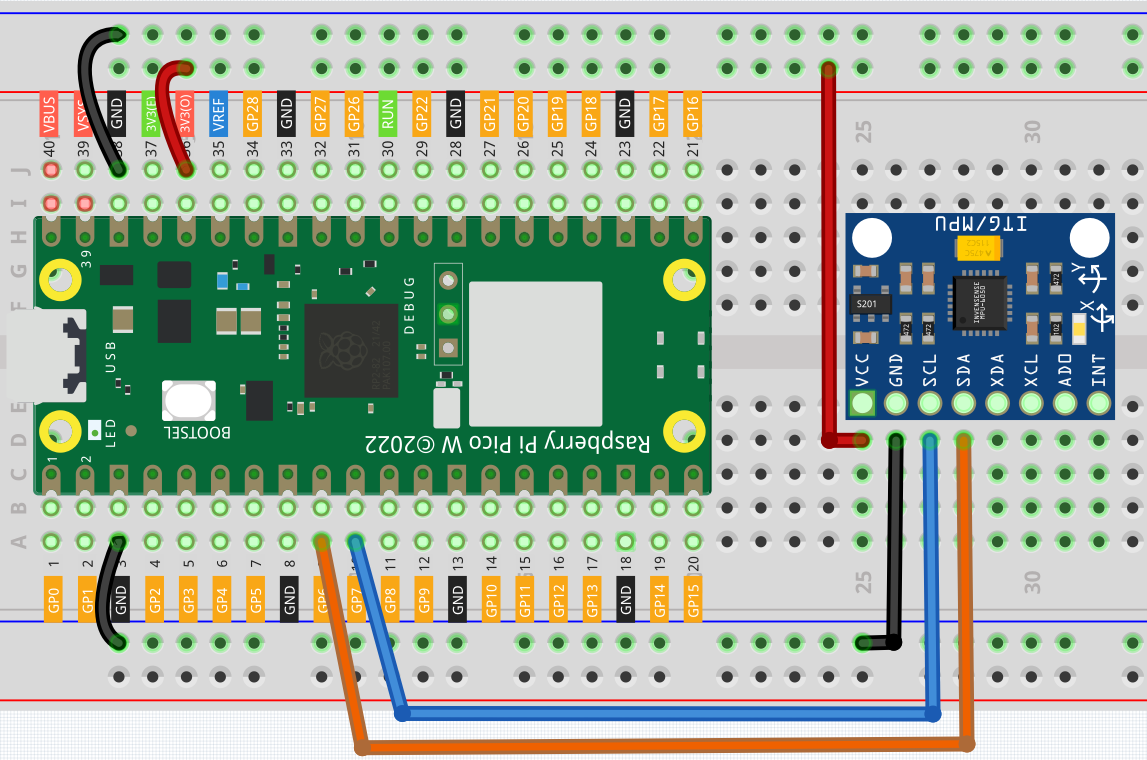6.3 - 6-axis Motion Tracking¶
The MPU-6050 is a 6-axis(combines 3-axis Gyroscope, 3-axis Accelerometer) motion tracking devices.
An accelerometer is a tool that measures proper acceleration.For example, an accelerometer at rest on the surface of the Earth will measure an acceleration due to Earth’s gravity, straight upwards[3] (by definition) of g ≈ 9.81 m/s2.
Accelerometers have many uses in industry and science. For example: inertial navigation systems for aircraft and missiles, for keeping images on tablets and digital cameras vertical, etc.
Gyroscopes are used to measure orientation and angular velocity of a device or maintenance. Applications of gyroscopes include anti-rollover and airbag systems for automobiles, motion sensing systems for smart devices, attitude stabilization systems for drones, and more.
Required Components
In this project, we need the following components.
It’s definitely convenient to buy a whole kit, here’s the link:
Name |
ITEMS IN THIS KIT |
PURCHASE LINK |
|---|---|---|
Kepler Kit |
450+ |
You can also buy them separately from the links below.
SN |
COMPONENT INTRODUCTION |
QUANTITY |
PURCHASE LINK |
|---|---|---|---|
1 |
1 |
||
2 |
Micro USB Cable |
1 |
|
3 |
1 |
||
4 |
Several |
||
5 |
1 |
Schematic
![]()
Wiring

Code
Note
You can open the file
6.3_6axis_motion_tracking.inounder the path ofkepler-kit-main/arduino/6.3_6axis_motion_tracking.Or copy this code into Arduino IDE.
Don’t forget to select the board(Raspberry Pi Pico) and the correct port before clicking the Upload button.
The library
Adafruit_MPU6050is used here. Please refer to Add libraries for adding it to the Arduino IDE.
After running the program, you can see the 3-axis accelerometer values and 3-axis gyroscope values cycling through the output. At this point you rotate the MPU6050 at random, and these values will appear to change accordingly. To make it easier to see the changes, you can comment out one of the print lines and concentrate on another set of data.
How it works?
Instantiate an MPU6050 object.
#include <Adafruit_MPU6050.h>
#include <Wire.h>
Adafruit_MPU6050 mpu;
Initialize the MPU6050 and set its accuracy.
void setup(void) {
Serial.begin(115200);
while (!Serial)
delay(10); // will pause Zero, Leonardo, etc until serial console opens
Serial.println("Adafruit MPU6050 test!");
// Try to initialize!
if (!mpu.begin()) {
Serial.println("Failed to find MPU6050 chip");
while (1) {
delay(10);
}
}
Serial.println("MPU6050 Found!");
// Set range
mpu.setAccelerometerRange(MPU6050_RANGE_8_G);
mpu.setGyroRange(MPU6050_RANGE_500_DEG);
mpu.setFilterBandwidth(MPU6050_BAND_21_HZ);
Serial.println("");
delay(100);
}
Get new sensor events with the readings.
sensors_event_t a, g, temp;
mpu.getEvent(&a, &g, &temp);
Subsequently, you will be able to get real-time acceleration and angular velocity values in the data a.acceleration.x, a.acceleration.y, a.acceleration.z, g.gyro.x, g.gyro.y, g.gyro.z.
Serial.print("Acceleration X: ");
Serial.print(a.acceleration.x);
Serial.print(", Y: ");
Serial.print(a.acceleration.y);
Serial.print(", Z: ");
Serial.print(a.acceleration.z);
Serial.println(" m/s^2");
Serial.print("Rotation X: ");
Serial.print(g.gyro.x);
Serial.print(", Y: ");
Serial.print(g.gyro.y);
Serial.print(", Z: ");
Serial.print(g.gyro.z);
Serial.println(" rad/s");